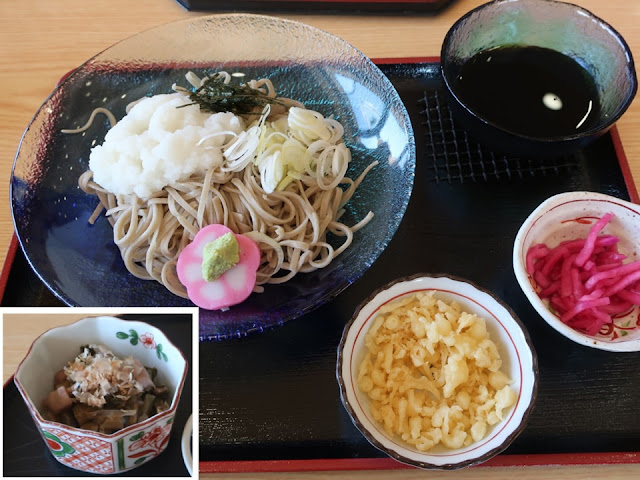Kaida Highland (1100~1200m above sea level) is at the foot of Mt. Ontake (3,067m) in central Japan. It was formed by the collapsing of Mt. Ontake around sixty thousand years ago. The land is barren and cold, however people had cultivated the land.
The photo below is the view of Kaida
Highland and Mt. Ontake from Kuzo pass, which is famous for autumn leaves
viewing spot. I was moved.
開田は御嶽山の麓、海抜1100~1200mに広がる高原です。約6万年前の山体崩落でできた場所で、痩せていて寒冷、厳しい土地なのですが、人々は切り開いてきました。
下の写真は、九蔵峠から見た御嶽山と開田高原。紅葉の名所です。美しかった。
Kaida people、開田の人々
Their photos are displayed at the entrance hall. They look tough.
エントランスに開田で生きてきた人々の写真が展示されています。たくましそうですね。馬がいて、「がんこじ」を背負って作物を運ぶ人がいます。
They went to the town center by train which carried lumber in around 1950. They got on the lumber not on a passenger carriage, didn’t they? The woman on the left sat like sitting on a tatami mat. If careless, you might fall down.
昭和20年代は、木曽福島へは林鉄軽便で行きました。客車ではなく、木材の上に載ったのですね。大人は正座しています。油断すると落ちますね。
Cart with rubber tires spread in around 1955. It’s a painstaking work to draw it on muddy road.
リヤカーが使用され始めたのは、昭和30年初期でした。泥道で、曳くのは大変そう。
The lady on the left puts on a straw raincoat for farming. The photo was taken in around 1950. They wear kasuri clothes, which were usually worn at a special work such as rice planting (I’m not sure they wore it because of photography).
左は、昭和20年代の野良仕事の雨具(すげみ)。撮影のためか、ハレの日なのか、絣を着ていますね。
The exhibition room is as large as one and half of a classroom. A taxidermy of Kiso horse is displayed. It was commended by giving birth to many ponies.
展示室は、教室一つ半ぐらいの広さです。木曽駒・春山号の剥製が展示されています。純血種で、多くの子をもうけ表彰されました。
Kiso horse、木曽馬
Kaida was famous for the breeding area of Kiso horse, which were farm horse or packhorse.
この地と純国産種の木曽馬/木曽駒は切り離せません。
Yamashita family owned lots of horses. The family-secret scroll above shows places for acupuncture.
大馬主の山下本家所蔵の「伯楽秘伝書」。上の絵には馬に針を打つツボが示されています。
The ex-Yamashita residence is opened to the public.
山下家住宅は公開されています。
Cultivating the land、開田
The difficulties and wishes of cultivating the land in the Edo period (1603~1868) were carved on stone monuments. I guess the pioneers left their hometown because of some reasons and moved to Kaida; they had a hard time.
江戸時代の田畑開発の苦労、願いが石碑として残されています。故あって住んでいた土地を離れて開発に携わったのでしょうが、大変なことだったと思います。
Agriculture、農業
Kida people (photos above) used the agricultural equipment and coats.
写真の彼らが使った農具です。
Making clothes from hemp、麻衣
They grew hemp, recovered fiber, twisted thread and weaved fabric (lower right). They carried through the long process to make clothes. The products are simple but heart-warming.
麻を育て、皮を掻いて、細かくして撚って糸を作り、生地(右下)を作ります。たくさんの工程があります。素朴で良い品ができていますね。
Forestry、林業
Physical work! 力仕事でした。
Worship、宗教
Exhibits on the right are implements of kou (religious group, on the left). Horses were drawn on the picture bords on the left and were offered to shrines.
右側は念仏講、左側は馬の絵馬などです。
Life、生活
The exhibit on the left is a portable stove. People boiled water and made tea at picnic. Some could warm sake (alcohol). It was a fun time, wasn’t it?
右側は、野外で湯を沸かし、茶を点てられる野風炉・携帯かまどです。お酒の燗をするものもありました。きっと楽しい会ですね。
Lunch boxes are also exhibited.
お弁当箱も展示されています。
The locomotive which carried lumber is exhibited outdoors. It is written, “The weight of this locomotive is 10 tons, which run on the other lines. In Kaida, small diesel ones (weight; from 4.1 to 4.5 tons) run. They carried only lumber and didn’t carry passengers.” Therefore, Kaida people sit on lumber, I just guessed.
屋外には、森林鉄道もが展示されています。「この機関車は、10t車で主に王滝線や小川線を走っていました。開田線は、木材運搬のみで客車は無く、自重4.1から4.5tクラスのディーゼル機関車が走っていました」と書かれています。木材運搬車に、人々が乗っていたのかもしれません(右上)。
Kiso horse is kept outside the museum. After finishing the role of farm horse or packhorse, the horses explore new roles such as for horse assisted therapy or for tourists' riding. Kiso horse is gentle, so they haven’t whipped it.
資料館の外では、木曽駒が飼われています。農耕馬や荷駄としての役割を終えた木曽駒は、保存が目的ではなく、観光用やホースセラピーなど、新しい役割を模索しています。木曽駒はやさしい馬で、鞭は入れないそうです。
Kaida Highland、開田高原
The view of Mt. Ontake from Ippongi-tei in Kaida. Kiso horses are grazed in the forest.
「一本木亭」から見た御嶽山。林では、木曽駒が放牧されていました(右下)。
The soba noodle with grated radish (white one) is a specialty of Ippongi-tei. It’s very spicy but delicious. It was a good season because soba was made from freshly harvested buckwheat. The pickles (lower left) are made of stems of red turnip; mountain people never waste edible plants. Moreover, precious salt is not used to make the pickles; it is pickled by lactic acid fermentation, so it’s sour!
一本木亭の名物のおろし蕎麦。右上のつゆをかけて食べます。辛くて美味しかった。新蕎麦でした。左下は「すんき漬け」。赤カブの茎を乳酸発酵させた木曽伝統のお漬物です。すっぱかったです。山の人々は、食べられるものを無駄にせず、手に入りにくい塩は使いませんでした。
Official website: https://www.town-kiso.com/facility/100028/
(in Japanese)
Visited in November, 2023
Previous post (museum in the same town): Kiso-Fukushima
local museum、木曽福島郷土館
Next post (museum at the foot of Mt. Ontake): Sato Terrace Mitake (Kiso Town Mt. Ontake Visitor Center) 、さとテラス三岳(木曽町御嶽山ビジターセンター)






















Comments
Post a Comment